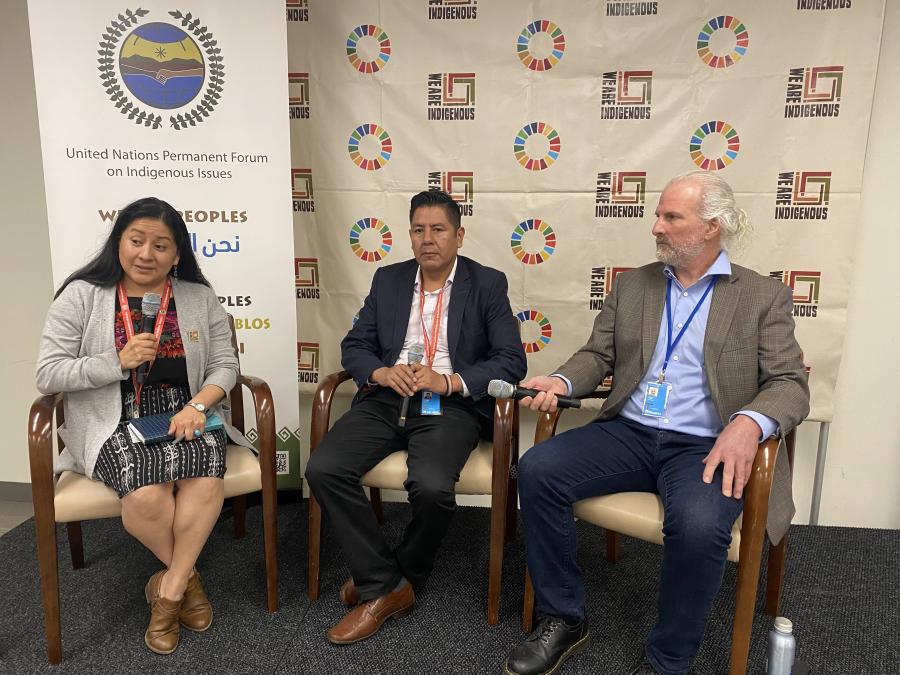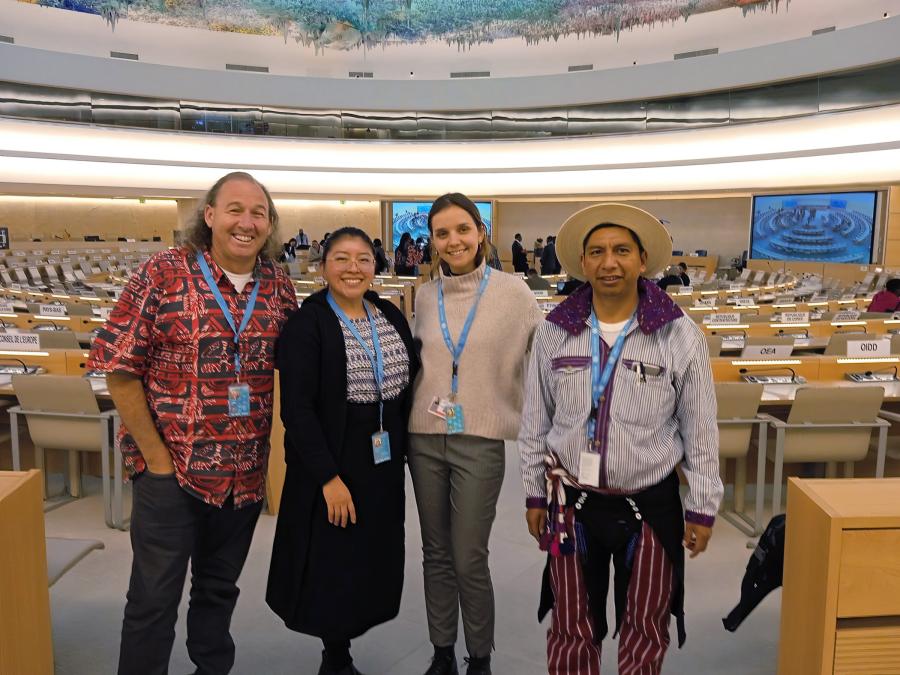On 19 July 1981, Mexico returned 1,855 Guatemalan refugees to their homeland.(°) Only 46, including 31 children, were given asylum. This was not the first time that Guatemalan Indian peasants fleeing the army's terror had crossed the borders en masse, nor was it the first time that Mexico had refused to grant them refugees status. Nonetheless United Nations sources and humanitarian organizations estimate that up to 70,000 Guatemalans might be in Mexico. Entire communities have been abandoned.
The exodus of this latest group of Guatemalans is all too representative of the conditions facing Guatemalan Indians today. In one instance, at dawn on June 17th, the 350 inhabitants of the agricultural cooperative El Arbolito in western Peten found themselves under assault. The heavily armed attackers broke into every home, firing shots, of value, especially the livestock, demanding the files of the cooperative, and taking $1,500 from the safe. Some of the men were walked 20 km to a military camp where they were kept in detention and interrogated about guerrilla activities. A week later two captives reported that they received no food or water, they were forced to lie in mud and their own excrement while their hands and feet were kept bound, and they were tortured. Other peasants, dragged from a number of cooperatives up and down the Usumacinta River, were also in the camp. According to the people from El Arbolito, some were brutally tortured and killed. The bodies were then thrown into trucks which were driven by soldiers wearing "uniforms with patches like tiger skin."
Word of the army's actions spread quickly. By June 24th, 1,901 people from 19 communities had sought refuge in Mexico after battling the dense jungle and crossing the Usumacinta River which separates the countries. Leaving their homes and cornfields was not easy. Their fear did not erase the deep pride they had in their communities. Reginaldo Aguilar, a 50-year old father of 7 children, who was a founder of the agricultural cooperative of El Arbolito in 1967, gave a detailed account of what he had endured in the military camp before leaving Guatemala. Besides his own ordeal, his 17-year old son Noe was killed by soldiers while he worked in the fields, and another son was kidnapped and has not been heard from since.
After all of this, however, Aguilar felt compelled to relate the circumstances under which the group had founded the cooperative, the hardships they had endured, and how they had made it work. He spoke of how he, his brother, and their families had come from the highlands knowing nothing of the secrets of the jungle and illness that awaited them. When they asked government officials for help to leave the jungle, they caustically reminded them that they had gone there to "colonize, not as tourists." Conditions were difficult; of the 30 families that had joined them the following year, only four remained. One person left to recruit new families but it took 3 or 4 years before many remained. In spite of these hardships. El Arbolito eventually became a prosperous agricultural cooperative of 81 families. Aguilar describes their achievements:
We grew maize beans, rice. We built our homes communally. We built a health center, a room for meetings, a little school, two houses to train health promoters, and a communal kitchen for gatherings. We had three launches, two with motors; and an electric plant that functioned from 6 to 9 PM and for two hours during the day it provided refrigeration in the communal store...the little we had we had achieved with many years of work and sacrifice. The work in the jungle is very hard. Now we had to abandon all that was our life...because of the persecution and killings that the soldiers carry out; they attack us as if we were at war.
He concludes his testimony by saying: "We can't go back to plant our crops because they kill us in the fields, or on the roads; we don't want to continue seeing how they kill the men in front of the women and children.
Ten years ago no one paid much attention to the northern territory of Guatemala. It was just referred to as the "Selva". Interest in Guatemala focused instead on the highland Indian communities. Tourists came by the bus loads to communities such as Chichicastenango in the Department of Quiche to marvel at the colourful market, the wonderful and varied dress, and the burning of incense on the steps of the Catholic church. Anthropologists primarily studied highland communities, fascinated by the culture of these Mayan descendants. Today, however, some of the heaviest fighting is taking place in Quiche, the churches have been closed, and the area is de facto under military occupation.
Intense land pressure in the highlands led more than half a million land-squeezed Indians to seek work for a few months every year on the plantations of the southern coast, the economic heartland of the country, where they harvested coffee, sugar, and cotton grown for export. In the late 60s and early 70s, however, the extreme land shortage kindled an interest in isolated and undeveloped areas. It was clear that the hundreds of thousands of idle acres in the coastal lowlands, fertile land frequently held for speculative purposes, would not be made available to the land-starved peasants. The dense jungle to the north because the only source of hope for the bravest or most desperate peasants from the highlands and a release valve for the government. Encouraged by foreign priests, who viewed colonization as a way to alleviate a minifundia problem worsening with each generation. Many Indians made the move to the jungle and formed agricultural cooperatives. In the face of nearly insurmountable odds, many of the cooperatives became self-sufficient.
Unfortunately, others with greater power have taken an interest in this forgotten area. The north has become a center of economic and political activity and now has an impressive sounding name to match - Franja Transversal del Norte (FTN).
After discovering nickel and oil in the area, the government began a massive frontier development program in 1976. Land values have increased not only because of the minerals but because an infrastructure of roads (most importantly the main east/west road), communication networks, and hydroelectric power plants have connected this one-time impenetrable area to the rest of the country. In addition a $30 million airport can accommodate the largest cargo and passenger planes in current use. Moreover, this 8,000 sq. km area is rich in lumber, and well suited for pasture, coffee, rubber, and cardamon.
The FTN has also become known as the "Zone of the Generals" because of the enormous tracks of lands falling into the hands of generals, in particular, the current president of Guatemala, Fernando Romeo Lucas Garcia whose prior job was running the development project for the northern strip. He is reported to own 130,000 acres.
The current oil production in the Rubelsalto and Chinaja fields alone is 6,600 barrels per day. And in his July 1 state of the union address, President Lucas Garcia announced that the government has granted permits allowing extraction of 8,000 barrels per day. A 10-inch pipe line, to be built eastward to the Atlantic coast, will transport the oil. In the first six months of 1981 oil exports totalled 390,000 barrels. Oil reserves in Guatemala have been compared to those of Alaska.
Four areas have been designated for exploration. Two of these, known as areas "F" and "K" are located in the Usumacinta area, home of the 19 cooperatives, which produced the latest refugees. These two areas comprise a total of 195,233.11 hectares and 139,135.80 hectares respectively.
On the eastern part of this allotted area, by the shores of the La Pasion River lies cooperative El Consuelo. This cooperative of 300 people was visited in June by representatives of the National Institute of Cooperatives (INACOP). They found a ghost community, garbage everywhere, no signs of life, or any explanation of where or why these people had abandoned their community. El Consuelo and El Arbolito are just two of dozens of cooperatives in the western Peten that are either partially or totally abandoned.
Activities in the FTN have sparked conflicts between the government, the Indians, the transnational companies, and the guerrillas. Some of the worst massacres in recent years have occurred here.
Amnesty International has entitled their report on Guatemala, "A Government Program of Political Murder". They state that "people who oppose or are imagined to oppose the government are systematically seized without warrant, tortured and murdered, and that these tortures and murders are part of a deliberate and long-standing program of the Guatemalan Government."
The government views the rural population, in particular, as potentially hostile, and many of the government atrocities seem designed to frighten the Indians and turn them against the guerrillas. They may however by having the opposite effect.
What is the future for returning refugees? None of the underlying factors that caused them to leave have changed: if anything, conditions are worse. Even if the government does not physically persecute them - an unlikely prospect - there are considerable material obstacles to resettling. The government is actively pushing these peasants off the land, and therefore, it is highly doubtful that resettlement aid or reparations for losses will be provided. More likely the atrocities will continue, resulting in many peasants leaving the cooperatives and others having to work in the FTN's development projects. One thing is for sure, they cannot pick up where they left off.
° In May an earlier group of some 400 Guatemalans were deported from Mexico. The Guatemalan Government placed these refugees in a military camp where reportedly 25 have been killed and many have disappeared
Article copyright Cultural Survival, Inc.



